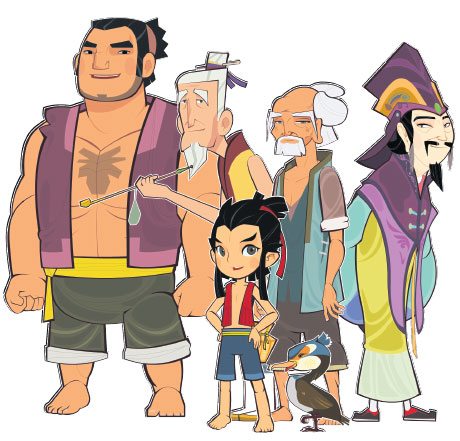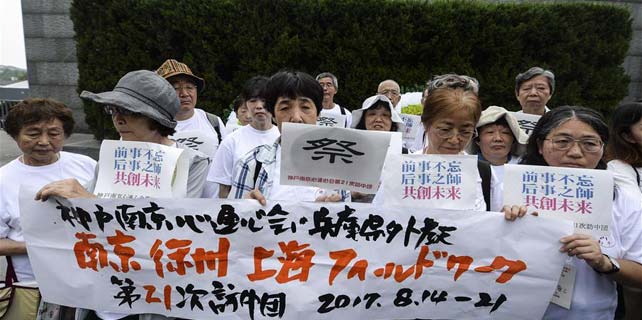Drawing audiences back to animation
Once upon a time, at the end of the best fairy tales, they all lived happily ever after. Then along came the animation film franchise - and if you wanted to know what happened in the end, you would just have to wait for the sequel.
So will the Chinese animation film industry, like many of the heroes and heroines it has produced over the years - at times standing tall, at times brought low, championing good and enduring the bad - stand tall once again?
The latest warrior riding the horse of high expectations for a return to the halcyon days for the industry is Da Hufa (Grand Sentinel), released in China on July 13.
The film's box office takings have been unimpressive, less than 90 million yuan ($13.5 million; 11.41 million euros; £10.37 million) in a month, whereas in the corresponding period last year, the Chinese animation Big Fish& Begonia took 560 million yuan, and a year earlier the animation Monkey King: Hero is Back took 950 million yuan.
|
Fisher Boy Story: Tortoise from the Sea by Zhang Liyan. |
However, there is a consensus among critics that Da Hufa's plot is stronger and much more reflective than those two others. On the Chinese ratings and review website Douban, Da Hufa has an overall rating of 8 out of 10, more than 90,000 reviewers rating it above 8. Kung fu Panda 3, which came out last year, has a rating of 7.7.

The Chinese-style drawing in Da Hufa and the violence throughout the film also got people talking about it.
That brings us back to talk of the good old days.
"The standard of Chinese animation has certainly declined compared with where it stood between the 1940s and 1960s," says Lu Shengzhang, 71, former dean of the school of animation at Communication University of China in Beijing.
"In those days, animations made by Shanghai Animation Film Studio were acclaimed throughout the world.
The first Chinese feature animation, Princess Iron Fan, was produced in 1941, four years after Disney's groundbreaking animation Snow White and the Seven Dwarfs, which remains one of the highest-grossing films of all time.
"It was under the influence of Princess Iron Fan that Osamu Tezuka, Japan's father of manga and the creator of Astro Boy, abandoned his medical studies and instead pursued a career in cartoons and animation," Lu says.
In 1961, another animation, Havoc in Heaven by Shanghai Animation Film Studio, based on the Monkey King story in the Chinese classic novel Journey to the West, was released.
With a soundtrack of traditional Chinese music and characters consisting of Peking Opera figures, the film would become a milestone that defined Chinese animation, winning numerous awards at home and abroad.
"The production of animation movies felt the effects of the 'cultural revolution' (1966-76), but there were many more good works to come, such as Nezha Conquers the Dragon King (1979) and Three Monks (1980)," Lu says.
"However, in the 1980s Chinese animation began to go into gradual decline."
The country abandoned the centrally planned economy in 1978, but it was not until 16 years later that the animation industry fully embraced the market.
Those years of lost opportunity resulted in a dearth of talent in the industry, with the old hands becoming even older and few young people being trained to fill the breach when they eventually departed.
With the old system gone and a market-based system remaining to be developed, the once-flourishing animation industry withered.
Lu, who has served on countless international animation festival juries over the years and was the director of animation for the Beijing Olympic Games mascot Fuwa in 2008, says: "I always feel embarrassed when my foreign peers say to me: 'Lu, have you got some good Chinese animation you can recommend?' The Dasheng (Monkey King: A Hero's Return) and Dayu (Big Fish & Begonia) are good, but not good enough."
Many Chinese who grew up in the late 1980s and 1990s cheerfully recall childhood days when they saw Japanese cartoon characters such as Astro Boy, Doraemon, Saint Seiya and Sailor Moon.
Television sets were then starting to become an integral part of Chinese living rooms, and TV stations made imported animation series a staple of their programming. One of the rare popular Chinese TV series was Calabash Brothers, a paper-cut animation aired in 1987.
Like many in China who became cartoon aficionados in that era, Zhang Liyan, the director of Calabash Brothers, who made a sequel last year to celebrate its 30th anniversary, gained his inspiration from Japan.
Zhang, 45, recalls the Japanese manga series Dragon Ball and its animated TV series when he was preparing to enroll for art college in 1990.
"It had a huge impact on me," says Zhang, who studied Chinese painting when he was a child.
"It opened my eyes, making me realize there was another way of drawing."

When an animation studio came to his school, scouting for recruits among students, the response was overwhelming, he says.
"Almost half the class applied, including me."
After two years of study and work, Zhang learned how to make animation and opened his own company in the mid-1990s.
He then spent a decade struggling to come to grips with the nascent private sector.
"It was very tough. Many companies were founded and just as quickly died, but I stuck to it because of my passion for animation."
In 2003, Zhang was given the opportunity to study traditional Chinese animation at the Shanghai Animation Film Studio.
"These old artists showed me how to make animation using puppet or paper-cut characters. Not only did they teach me so much, but their wisdom and dedication inspired me."
Since then, he has made several animations in the traditional Chinese style, using ink and brush, puppet and paper-cut.
Zhang's ambition to revive traditional Chinese animation is materializing in his project Fisher boy Story: Tortoise from the Sea, an animated film featuring Chinese paper-cutting techniques that he hopes will go on the big screen next year.
In the film, Zhang's team has used computers to replicate the texture and feel of paper-cut characters, and has set the story in the Ming Dynasty (1368-1644), telling how a young fisherman overcomes his fear of water, and of his adventure with a huge tortoise.
Tradition is guiding other animators as well.
"Chinese early animations were not commercial products," says Li Guanyu, 37, the head of the animation department at Communication University of Shanxi. "These animations were art."
Li, founder of an animation studio in Shanxi province, Shrub Culture, says that when he was a child he was fond of Japanese manga and Chinese traditional picture-story books.
He opened a student cartoon club and sold comic books when he was still in college in Taiyuan, Shanxi province.
In 2002, he obtained a degree in graphic design and went to Beijing, where he worked with various companies for a year before studying at Shanghai Animation Film Studio for six months.
His excitement is clear as he recalls that experience.
"Despite their age, the old artists taught us the very details of the animations they made," he says, before reciting a string of artists' names and their works.
"I was fond of animation before and did not foresee how far I would go on this road, but after seeing the enduring passion of the older practitioners, I realized that making good animation is worth a lifetime."
Li thinks all animation is shaped by the art of the time.
Works by Shanghai Animation Film Studio are heavily influenced by traditional Chinese art, he says.
"For example, the chief artist of Havoc in Heaven, Zhang Guangyu, took in elements from folk decoration to design the anime's background."
These animations were made by the country's top directors and artists, too, he says.
"The director of Havoc in Heaven is Wan Laiming, one of the Wan brothers who were the trailblazers of China's animation."
Since those days, making Chinese traditional art appealing to modern people has gradually become Li's guideline in his creation. At the moment, his studio is working on an animated TV series, Kiki and Kaka.
The main characters are two tigers in the form of cloth dolls, a traditional craft in Shanxi listed as a national cultural heritage in 2008.
"My children liked it," says Li, a father of two. "They have watched it over and over again."
Since 2000, the government has given more attention to the state of the animation industry, aware that the country's screens had been dominated by foreign characters for more than a decade.
In 2000, the State Administration of Radio, Film and Television issued a guideline on importing and broadcasting foreign animation, setting a ratio of 6 to 4 for aired domestic and foreign animation, and limiting the airtime of foreign animation to less than a quarter of each children's program.
In 2004, the administration issued advice on developing the country's animation industry, encouraging more productions, airtime, financial incentives and management.
They were signals from the government that were well received by the country's young animators, He Zhanwei among them.
After obtaining a degree in applied arts, He embarked on an animation career in Hunan province in 2004, joining a company that was producing China's longest animation series, Naughty Blue Cat's 3,000 Questions. The series, with more than 2,000 episodes, was broadcast until 2012.
"I learned how to make animation fast there," He says. "In my father's generation, China was building its industrial economy, and now it is turning to the cultural economy."
In China, about 82,000 minutes of animation was produced in 2001, a number that more than tripled to 261,000 in 2011, according to The History of Chinese Animation, a report by researchers at the Communication University of China.
In 2010, the country overtook Japan as the largest producer of animated films.

However, there is a downside to that increased output, many animation companies being set up simply to obtain government subsidies granted for animation that could be regarded as mediocre at best, industry insiders say.
In an interview in 2011, Lu said: "Without quality there can be no animation industry.�� China cannot become a leading animation producer by producing quantity at the expense of quality."
In 2011, production figures began falling, and last year 119,000 minutes of animated film were made in the country, the National Bureau of Statistics says.
"It was about that time that I realized the culture industry is unlike any other industry," He says. "It takes time and it takes talent."
He is the founder of the social networking app for animators, Cloud of Artists, on which they can display their profiles and portfolios to potential employers.
The app organized its first offline job fair in Beijing on July 15, attracting 50 animation companies and hundreds of job seekers.
"What is keeping China's animation industry back is a lack of professionals and those skilled in storytelling," He says. "We want to connect the right people with companies in need."
Like many others in this industry, he is optimistic, saying that over the coming decade "Chinese animation will take off again".
That optimism is backed by a growing thirst for original Chinese animation.
There were more than 45,000 movie screens in China by the end of June, surpassing the total in the United States, and making China the country with the most cinemas. Last year, animated movies pulled in 7 billion yuan, about 15 percent of the country's total box office.
A growing subculture of animation, comics and games has spread among young Chinese, and the works they hanker after, including original Chinese animations, are among the highlights at expos around the country every year.
Earlier this year, a short animations series titled Chinese Choir was well received on the video website Bilibili, the largest online group of young Chinese animation, comic and games fanatics.
Each video, telling the story of an ancient Chinese poem with traditional music, has received hundreds of thousands of clicks.
The enthusiastic comments from viewers, such as "The Chinese-style drawing is so cool", "This is true Chinese animation" and "We support original Chinese cartoons," suggest that the story of the country's animation industry will indeed have a happy ending.
xingyi@chinadaily.com.cn
( China Daily European Weekly 08/18/2017 page1)























